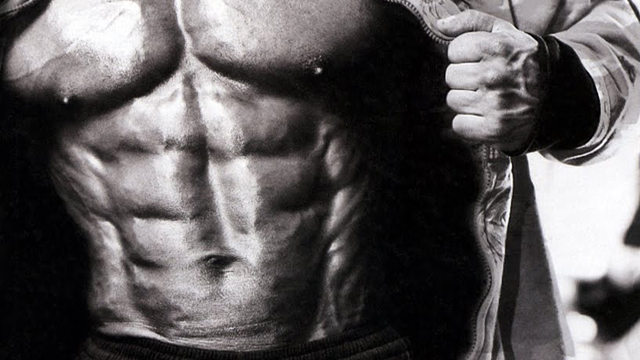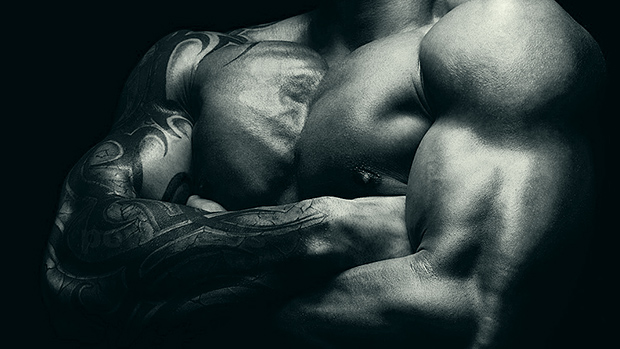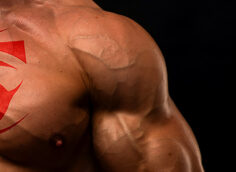The most underutilized pieces of equipment in most gyms are the
dumbbells. Oh sure, you might see people pumping out a few sets of
biceps curls, bench presses, or flyes, but in most gyms the
dumbbell racks are primarily used as a place to lean against
between sets of barbell squats or benches.
So why are dumbbells so underutilized? I believe it's because,
for most people, the barbell is the standard of reference. We're
used to thinking about how much we can clean, squat, or bench with
a barbell - not dumbbells. After all, powerlifting and Olympic
lifting meets involve only barbells. And in athletic weightrooms,
records are kept on how much the athletes can lift with a barbell, not dumbbells. In many ways, that's unfortunate.
6 Advantages of Dumbbell Training
This emphasis on barbell training is unfortunate because
dumbbells provide significant advantages to athletes, bodybuilders,
and those training for general fitness. These advantages
include:
1. Dumbbells require more balance than training with barbells or
machines. This increased balance requirement is of value in terms
of enhancing athletic performance, a significant consideration in
fitness programs, and can lead to greater muscle fiber recruitment
for the bodybuilder.
2. Dumbbells require more muscular control than barbells,
enhancing kinesthetic awareness.
3. Dumbbells allow unilateral training (training one limb at a
time), which can provide the opportunity for emphasizing greater
movement specificity in the training programs of athletes and
greater program variety for bodybuilders and those training for
fitness. Adding a few sets of dumbbell alternating bench press to
your workout is a great way to change it up and challenge the body.
4. Dumbbells promote greater recruitment of the stabilizing
muscles, enhancing joint stability and hypertrophy.
5. Some exercises can be performed with a higher degree of
safety with dumbbells than barbells. For example, when performing
step-ups, if you lose your balance it's much easier and safer to
drop the dumbbells from your hands than it is to allow the barbell
to slide off your back!
6. Finally, dumbbells provide greater variety in the training
program. Greater variety leads to less opportunity for
physiological and psychological staleness in the training program,
enhancing the opportunity for continued growth.
Points of Emphasis
As a strength and conditioning coach in an athletic training
program, there are a couple of points of emphasis I want to make
regarding dumbbell training. First, as mentioned above, dumbbells
allow for training with a higher degree of movement specificity.
It's not enough to train the appropriate muscle groups; rather, you
want to select exercises that mimic movements that make up the
sport you're training for.
The greater the similarity between the resistance training
movement and the sports movement, the higher the value your time
spent training will be. That's why our athletic weightrooms at the
Air Force Academy have far more squat racks than leg extension or
leg press machines. Similarly, dumbbells allow us to do a better
job at mimicking some of the movements that make up athletic
performance than only using barbells does.
Secondly, except in the sports of powerlifting and Olympic
lifting, the ability to demonstrate maximal strength in bench,
squats, cleans, or snatches isn't the deciding factor in the level
of success the athlete will have. As a coach I sometimes have to be
willing to sacrifice maximal increases in certain exercises in
order to train sport specific movements.
For example, I can't just have my football players squat;
they also need to perform lunges, side lunges, and pivot lunges.
The time and energy spent performing some of these sport specific
exercises likely hinders their ability to maximally develop their
squats, but since football is an athletic competition and not a
weightlifting competition, I have to be willing to sacrifice their
max squats and include these other movements in their training
program.
Similarly, if I was only concerned about how much my athletes
could clean with a barbell, I wouldn't include dumbbell cleans in
their training programs. But since performing dumbbell cleans
allows unilateral training rather than only bilateral training, we
clean twice per week - once with a barbell and once with
dumbbells.
The same holds true for bodybuilders. Since success as a
bodybuilder is determined by the level of muscular development
rather than strength levels, it makes sense to include dumbbell
training as part of the overall training program.
Performing dumbbell bench press on a regular basis may not be
the best way to develop a huge barbell bench max; however, since
performing the bench press with dumbbells changes up the muscle
fiber recruitment pattern - and the greater the number of
fibers recruited the better the opportunity for optimal levels of
hypertrophy - it also makes sense for the bodybuilder to
sacrifice max increases in strength levels as a result of
emphasizing dumbbell training.
Dumbbell Integration
So what's the best way to integrate dumbbells into your training
program? We split our training days into barbell days and dumbbell
training days. For example, with our football athletes, our skill
position athletes lift three days per week - twice with a
barbell emphasis and once with a dumbbell emphasis. One of the
barbell days has a lower body emphasis; the other has an upper body
emphasis. On the dumbbell day we train both lower and upper body.
Our other football athletes (offensive line and tightends,
defensive line and linebackers, fullbacks) train four days per
week, twice with barbells and twice with dumbbells. Two of the
workouts have a lower body emphasis; two of the workouts have an
upper body emphasis. One of the lower body workouts is barbell
oriented; the other is dumbbell oriented. The same holds true with
this group's upper body workouts. That allows us the opportunity to
make sure our athletes are gaining the optimal advantages dumbbells
can provide in both lower and upper body training.
Dumbbell Exercises (That You've Probably Never
Tried!)
Presented below is a sample of some of the dumbbell exercises we
have our athletes perform. You may want to try some of these
movements the next time you find yourself leaning up against that
dumbbell rack!
You'll find some of these exercises (e.g., dumbbell split alter
foot alter snatch) challenging to perform and perhaps somewhat
awkward initially. That's by design, because we use the
movements not only to increase sport specific strength, but also to
enhance motor skills and coordination.
Also, you'll notice that I advise on several of the exercises to
keep the knees behind the toes, as when performing a dumbbell front
squat. This recommendation is made for one simple reason: the basic
athletic position is a shoulder-width stance, head up, back arched,
hips back, and knees behind or on top of the toes.
When's the last time you've seen someone shoot a basket, throw a
pass, or hit a baseball in a knees forward of the toes stance? I
want my athletes to train in the weightroom in positions similar to
the positions they'll find themselves in during
competition.
Okay, let's get to the exercises!
DB Hang Squat Alter Cleans
 |
 |
 |
 |
Start with the feet in a shoulder-width position. The back
should be arched, the head up, arms straight. Assume a hang
position by placing the dumbbells at the sides of the body, pointed
anteriorly and posteriorly, with the handles of the dumbbells
centered with the knee joint.
Initiate the movement by performing a vertical jump action,
extending up onto the toes. At the top of the jump, perform an
aggressive shrugging action and then bring the right dumbbell up
along the rib cage to a chest high position while the dumbbell in
the left hand stays in the start position. At this point, bring the
right elbow up and around, racking the dumbbell on the right
shoulder while simultaneously dropping into a semi-squat position.
Continue the squatting action until a parallel squat position is
achieved, keeping the knees behind the toes. Keep the right elbow
high, the head up, and the heels on the ground while squatting.
Return to a standing position, lower the right dumbbell, and repeat
the movement with the left arm.
DB Hang Split Alter Foot Alter Snatch
 |
Initially, this movement is identical to performing a dumbbell
clean. Start with the feet in a shoulder-width position. The back
should be arched, the head up, arms straight. Assume a hang
position by placing the dumbbells at the sides of the body with the
handles centered with the knee joint.
Initiate the movement by performing a vertical jump action,
extending up onto the toes. At the top of the jump perform an
aggressive shrugging action, and then bring the dumbbell in the
right hand up along the rib cage to a chest high position while the
dumbbell in the left hand stays in the start position.
When the right dumbbell reaches a chest high position, initiate
a splitting action with the legs. With the right dumbbell moving
over head into a locked-out position, the left leg should be split
forward and the right leg should be split rearward.
"Regather" the legs, lower the dumbbell, and repeat the action
with the left hand while the legs are split in the opposite
direction just described so that the forward foot is always on the
opposite side of the dumbbell that's been snatched
overhead.
DB Split Alter Foot Alter Jerk
 |
 |
 |
Position the dumbbells on the shoulders by performing a dumbbell
clean. Assume a shoulder-width foot position. Using a jumping
action, lower the hips back and into a jump position, and then
immediately reverse the direction of the hips into a fully extended
position.
As the hips reach a fully extended position, simultaneously
aggressively extend the right arm overhead and split the legs so
that the left leg goes forward and the right leg splits backward.
Regather the feet, lower the right dumbbell back to the shoulder,
and repeat the movement so that the left arm extends overhead and
the right leg is split forward.
DB Front Squats
 |
 |
Clean the dumbbells to the shoulders. Assume a shoulder-width
stance, arch the back, and keep the head up. Reach back with the
hips and sit back into a parallel squat position, keeping the heels
on the floor and the knees behind the toes. Return to the start
position and repeat.
DB Side Lunge
 |
 |
Hold a dumbbell in either hand. Assume a shoulder-width stance.
Step directly to the right with the right leg into an exaggerated
side lunge position. At the same time, sit back with the hips,
keeping the right knee behind the toes. The left leg should remain
straight at the knee during the lunge to the right.
Lower the hips through a full comfortable range of motion. At
the bottom of the position, push aggressively with the right foot
and return to the starting position in one step. Repeat the
movement to the left.
DB Arch Lunge
 |
 |
 |
Hold a dumbbell in either hand. Assume a shoulder-width stance.
Imagine an arch in front of you, running from a stride's length
directly lateral of your right foot, to a stride's length directly
in front of you, to a stride's length directly lateral to your left
foot.
Perform a side lunge with your right foot, stepping on the right
corner of the arch. Return to the starting position; alternate feet
each step. With each step gradually progress from the right corner
of the arch to the left corner of the arch, with the last step
being on or near the left corner of the arch. None of the steps
will be directly forward. Pivot off the back foot each
step.
DB Alter Bench Press
Perform a standard dumbbell bench press movement, but rather
than pressing both dumbbells simultaneously, alternate between
pressing the dumbbells with the right and left hands.
 |
 |
 |
Make sure to completely lower the right dumbbell back to the
chest before pressing the left dumbbell away from the chest and
visa versa. You may be surprised how challenging this exercise
becomes when performed in this manner!
DB Press Crunch
 |
 |
Lie on your back, bend your knees, and place your feet flat on
the floor. Hold one dumbbell on end cupped in your hands over your
face, placing your hands on the inside portion of the plates that
are at the top end of the dumbbell.
Crunch upward, elevating the upper back off the floor as far as
possible. Try to press the dumbbell straight up toward the ceiling
rather than moving forward toward the wall.
Your Turn!
Dumbbell training provides many unique benefits to the athlete
and bodybuilder. Integrate a few of these exercises into your
regular program and see for yourself!




